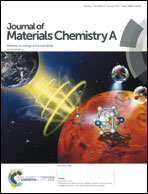Solvent-resistant and fully recyclable perfluoropolyether-based elastomer for microfluidic chip fabrication†
Abstract
Polydimethylsiloxane (PDMS) is a popular choice for the microfluidic chip fabrication; however, it still meets several significant challenges, including poor solvent compatibility, non-reprocessability, and non-recyclability. The innovation of new elastomers that overcomes these drawbacks pushes forward the application of microfluidics in organic synthesis and avoids potential environmental threats from chip waste. Herein, we reported a solvent-resistant perfluoropolyether (PFPE)-based thermoset elastomer that can be reprocessed like thermoplastics and degraded back to its raw material. The solvent-resistant elastomer was synthesized by crosslinking PFPE-diol into a dynamic covalent network. Since the PFPE chain is repellent to most solvents, this PFPE-based elastomer exhibited much lower swelling ratios in comparison with PDMS. Dye diffusion experiments on microfluidic chips convinced about the success in preventing swelling-induced dye leakage or diffusion. To present the thermoplasticity and reprocessability, one specific spiral microfluidic chip was cut into small pieces and reshaped into another chip that allowed laminar flow of two types of solutions. Moreover, the PFPE-based elastomer was chemically degraded and over 90% PFPE-diol was recycled. This solvent-resistant and almost fully recyclable elastomer provides a new material choice for microfluidics and is bound to play an important role in microfluidic studies with respect to organic chemistry.



 Please wait while we load your content...
Please wait while we load your content...